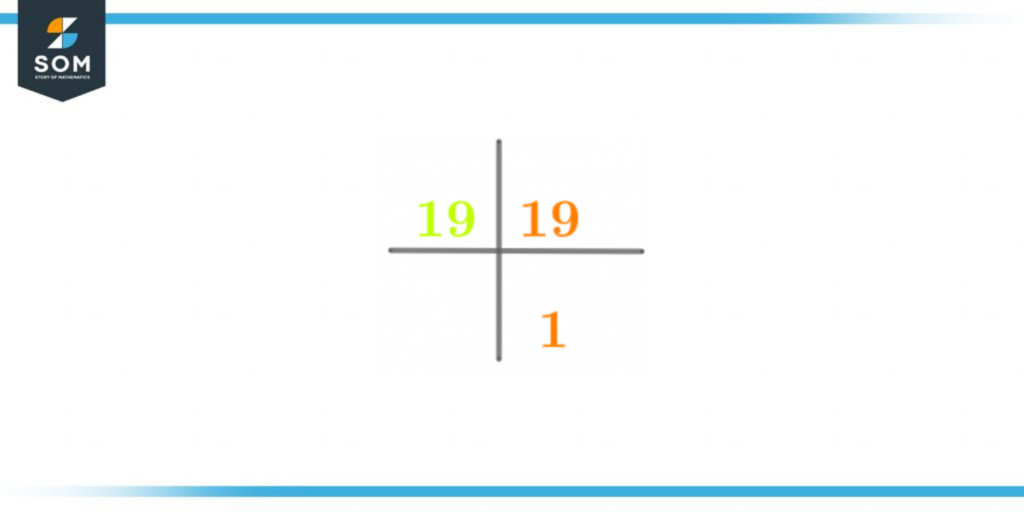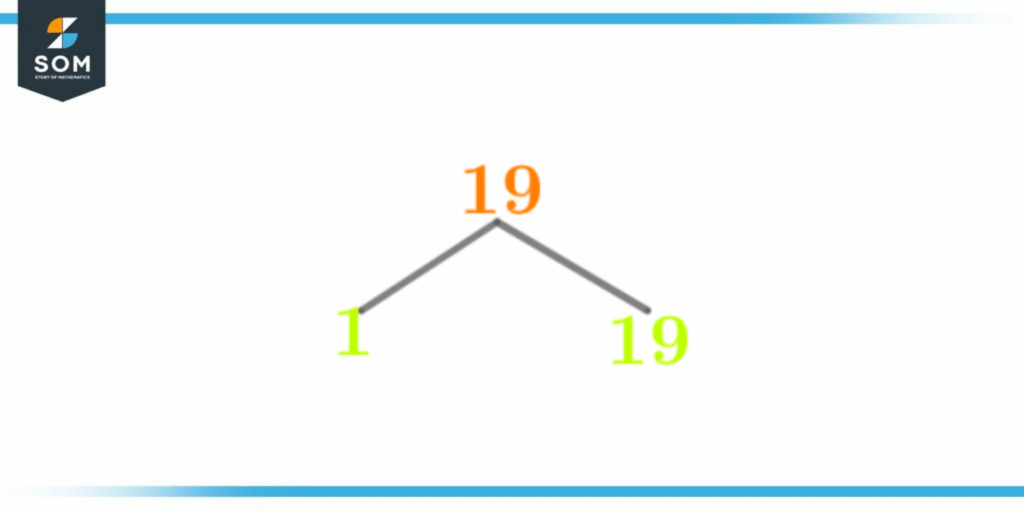JUMP TO TOPIC
Factors of 19: Prime Factorization, Methods, Tree, And Examples
The Factors of 19 are the numbers upon which the number 19 is completely divisible, meaning that when the number 19 is divided from such numbers; zero is left as a remainder along with a whole number quotient.
Figure 1 – All possible Factors of 19
1 x 19 = 19
As the number 19 is a prime number so it can be concluded that it will only have 2 factors.To learn more about these factors and how to determine them, along with some solved examples, let’s dive into the details of the factors of 19 in the article given below.What Are the Factors of 19?
The factors of 19 are the numbers 1 and 19. Since 19 is a prime number so its factors are also prime numbers. These numbers yield zero as the remainder when they act as the divisors for the number 19.In total, the number 19 has 2 factors. These factors are both positive as well as negative.How To Calculate the Factors of 19?
You can calculate the factors of 19 by a technique which is known as the division method. As the name suggests, the division method is based on the operation of division in which the number itself acts as the dividend and the potential factors act as the divisors.Before applying the division method to the number 19, let’s first go through the basic conditions required for a number to be qualified as a factor. There are generally two conditions for this.The first condition is that the number that acts as the divisor must produce zero as the remainder after the division procedure. The second condition is that along with the remainder being zero, the number must also produce a whole number quotient.If these two conditions are met, then the number acting as the divisor can be qualified as the factor for a number. Keeping this in mind, let’s take a look at the number 19. The number 19 is a prime number and prime numbers only have two factors – one being the smallest factor 1 and the other being the number itself.Now let’s apply the division method to the number 19:\[ \frac{19}{1} = 19 \]When the number 1 acts as the divisor, both the conditions for the factor qualification are met which indicates that the number 1 is a factor of 19.Now, let’s take a look at the division of 19 with the number 19 itself. The division is shown below:\[ \frac{19}{19} = 1\]As both the conditions are again met, hence the number 1 also qualifies to be a factor of 19. So the factors of 19 are given below:Factors of 19 = 1 and 19These factors can be negative as well. The negative factors are the same as positive factors, the only difference is the negative sign. So the negative factors of 19 are given below:Negative Factors of 19 = -1 and -19Factors of 19 by Prime Factorization
The prime factorization is a technique through which the prime factors of a number are determined. The prime factors are known as those numbers which are the factors but are also prime numbers. For the prime factorization of the number 19, since 19 itself is a prime number so the factors this number has are also prime numbers. Hence, all the factors of the number 19 can be categorized as the prime factors.The process of prime factorization is similar to simple division, the only difference is that prime numbers carry the division. The division process is continued until only the number 1 remains in the end.The prime factorization of the number 19 is shown below:Prime Factorization of 19 = 1 x 19
The prime factorization of 19 can be seen in figure 1 provided below:
Figure 2 – Prime Factorization of 19
Factor Tree of 19
Another method for determining the prime factors of a number is through the factor tree. As the name suggests, the factor tree has a structure similar to a tree and consists of multiple branches which extend out from a given number.These branches split into a divisor and a whole number quotient. Since the factor tree also makes use of the division process for determining the prime factors, hence it can be recognized as the pictorial description of the prime factorization of a number.The prime factors are always available at the end branches of the factor tree.The factor tree for the number 19 is shown below in figure 2:
Figure 3 – Factor Tree of 19
Factors of 19 in Pairs
Another unique aspect regarding the factors of any number is that these factors can also exist in the form of pairs known as factor pairs. Two factors together constitute a factor pair.The condition for the existence of a factor pair is that when then numbers within a factor pair are multiplied, they yield the original number as the product. As the number 19 only has 2 factors so it consists of a single factor pair. This factor pair is given below:1 x 19 = 19
Factor Pair of 19 = (1, 19)
Since factors of any number are both positive as well as negative so the same applies to the factor pairs. The factor pairs for a number can be negative as well. The only requirement of negative factor pairs is that both the number within the pair must have a negative sign so that when they are multiplied together, a positive product is obtained.The negative factor pair is given below:-1 x -19 = 19
Negative Factor Pair of 19 = (-1, -19)
Some interesting facts about the number 19 are given below:- The sum of the individual digits in the number 19 is 10 which is an even number: 1 + 9 = 10
- In the series of prime numbers, the number 19 is the eighth prime number.
- The number 19 is a centered hexagonal number which means that 19 dots can be arranged together in the form of a hexagon such that all the other dots surround the original dot.
- The number 19 in roman numerals can be written as XIX which is the same number written backward.
Factors of 19 Solved Examples
To further comprehend the concept of the factors of 19, given below are a few examples involving the factors of 19 that can help you with the concept.Example 1
Calculate the sum of the factors of 19 and then determine the prime numbers this sum is a multiple of.Solution
To begin with the solution of this example, let’s first list down the factors of 19. The factors of 19 are given below:Factors of 19 = 1 and 19Now, the next step is to calculate the sum of the factors of 19. Calculating the sum of factors of 19:Sum of factors of 19 = 1 + 19
Sum of factors of 19 = 20
Now, let’s move on to determining the prime numbers which can include the number 20 as a multiple. Let’s take a look at the series of the first 5 prime numbers:First 5 prime numbers = 2, 3, 5, 7, 11
Now, let’s analyze the number 20. It is quite obvious from analyzing the number that the number 20 is an even number which indicates that the number 20 is a multiple of the prime number 2 as shown below:2 x 10 = 20
Furthermore, the number 20 ends at a zero which indicates that this number can also be a multiple of the prime number 5 which is shown below:5 x 4 = 20
So the two prime numbers for which the number 20 can act as a multiple are the numbers 2 and 5.Example 2
Calculate the difference of the factors of 19.Solution
Firstly, let’s note down the factors of 19.Factors of 19 = 1 and 19Now, calculate their difference:Difference of factors of 19 = 19 – 1
Difference of factors of 19 = 18
Hence, the number obtained as the difference of the factors of 19 is 18. This number 18 is a multiple of both the prime numbers 2 and 3. All images/mathematical drawings are created with GeoGebra.